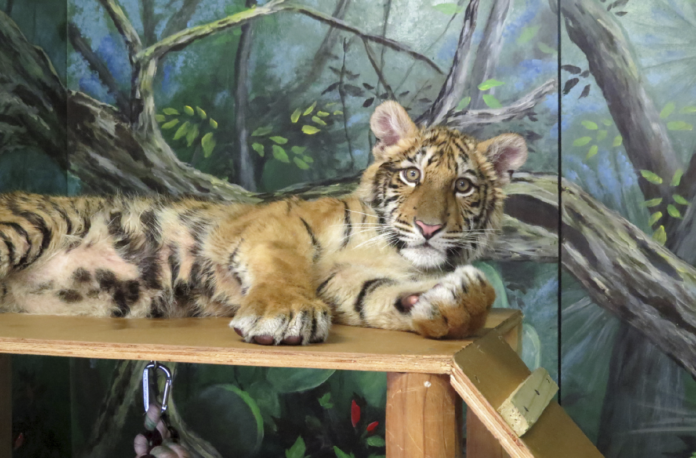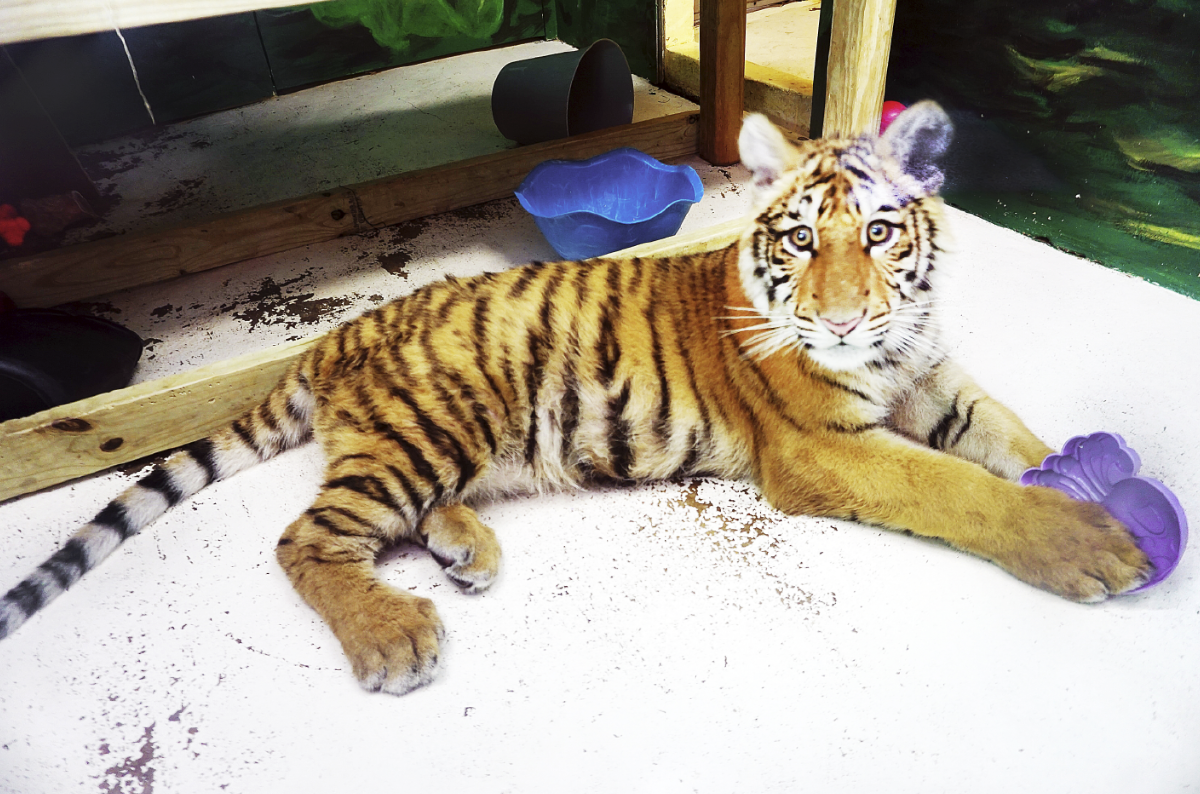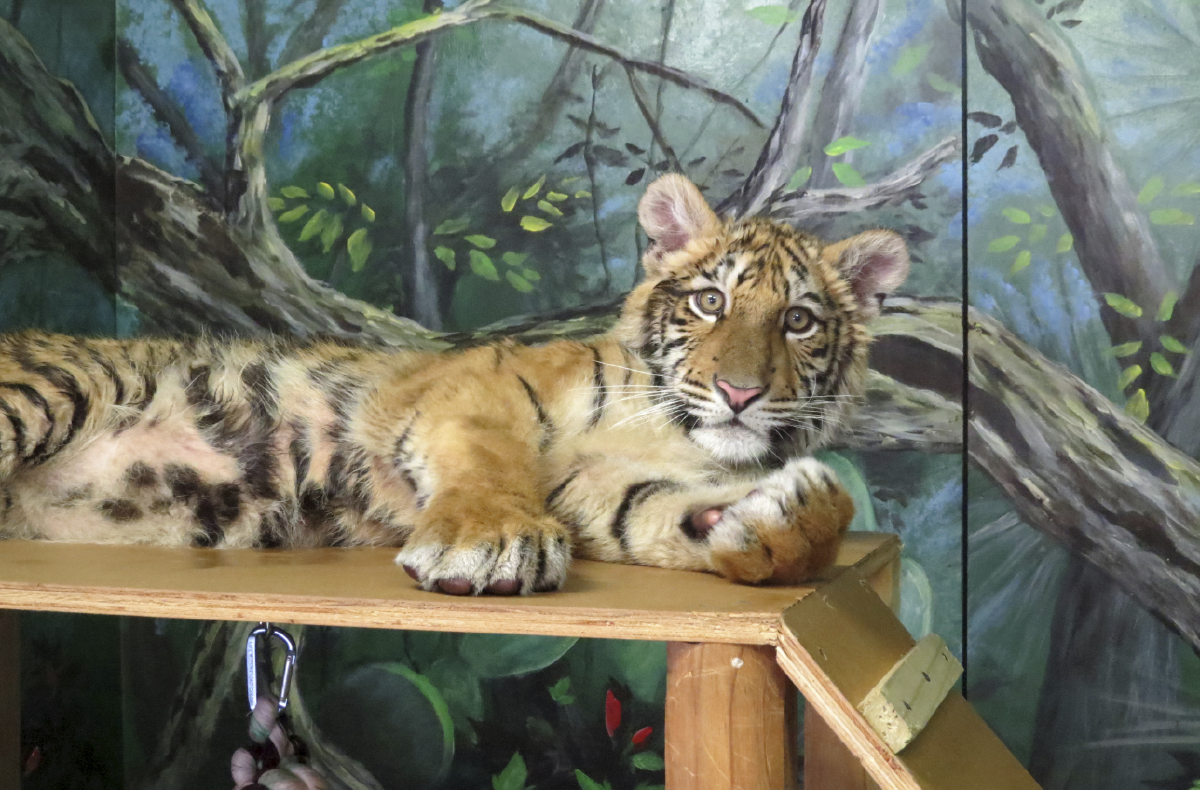BROWNSVILLE — After its near-death experience several months ago, the tiger cub that was rescued near the border fence in Brownsville is alive, healthy and ready to go to its new home.
“The tiger cub is doing very well,” Gladys Porter Zoo senior veterinarian Thomas DeMaar said. “It has gained weight. It has pretty much doubled in weight since it arrived. … He has bounced back from his ordeal and, in a few days, he will be leaving here and is going to a sanctuary in Wylie, Texas, that specializes in caring for large cats that don’t have a home.”
Border Patrol Agent Marshall Maynard discovered the now 3-to-4-month-old tiger cub motionless in a black duffel bag on April 30 after three people who crossed the Rio Grande abandoned the animal and fled back to Mexico before the federal agents could close in on their location.
On Thursday, the tiger cub will be transported to In-Sync Exotics, a wildlife sanctuary in Wiley that is home to more than 75 exotic cats, including lions, cougars, leopards, cheetahs, lynx, servals, an ocelot and 35 tigers.
DeMaar said the cub was “on death’s doorstep” when the Border Patrol agents brought the animal in for treatment in April. The tiger cub had a temperature of 107 degrees.
“It’s safe to say that had this ordeal gone on for even 30 minutes longer, if he’d been in that duffle bag for another 30 minutes, we would not be having this conversation today; he would’ve been dead,” he said. “Fortunately, the timing was perfect. Through various medical methods, the veterinarian staff at the zoo brought his temperature down. There was a day or two when we were wondering if he was recovering, but he did very well.”
At his new home in Wiley, the 70-pound tiger cub will have a “playmate” as it will be placed with another tiger of about the same age, according to DeMaar.
In the meantime, the senior veterinarian said visitors have been interested in the tiger cub since its arrival.
The zoo took the rescue as opportunity to create an exhibit to teach its visitors about wildlife trafficking.
“We created an exhibit on wildlife trafficking to teach the public about the dangers of wildlife trafficking, how wildlife individuals and wildlife parts, either shells, all different types of things, skins, feathers, are transported around the world,” DeMaar said. “Sometimes, people don’t even know that these things are prohibited or that they have a serious effect on wildlife conservation. These animals are being extracted from their natural habitat and put in as commercial entity.”
The exhibit and tiger cub have attracted numerous visitors to the zoo, including Harlingen resident Mary Garcia who said she has followed the animal’s story since its rescue in April.
“He looks really healthy and his fur is real nice,” Garcia said. “That’s so awesome that we’re so lucky that we have a zoo here that can take care of him.”
Garcia was visiting the zoo with her family and said seeing the tiger cub was a pleasant surprise for all of them.
The tiger cub is “extremely playful,” DeMaar said.
“When it comes to people in the public, he seems very alert and he probably would want to interact with all the people if the window wasn’t there,” he said.
Garcia said she is happy the zoo placed an exhibit that shows visitors how wildlife trafficking harms animals.
“I think it’s so sad,” Garcia said. “These animals, they’re wild animals. They shouldn’t be pets. People shouldn’t try to make them to be pets. They’re so beautiful but they can be so dangerous too. You never know when they get older.”
In his 11 years at Gladys Porter Zoo, DeMaar said the rescued cub was the 13th tiger that has been brought to the facility after being recovered at the border, confiscated from illegal sellers or, in one case, the product of a divorce.
“We do see a lot of animal trafficking,” he said. “In the last couple of decades, it was much more everything coming from Mexico to the United States. Now, we’re actually seeing it in both directions. We have just as many animals confiscated going south and north. The zoo houses them until such a decision is made as to where they can go. A lot of times, we don’t really want them, but we are offering that as a community service, and, unfortunately, there’s really no budget for these projects. Agencies do not have a budget to take care of these animals that don’t have a home. So, it comes out of the zoo’s budget.”
People still have an opportunity to visit the tiger cub before it leaves Thursday. DeMaar said there is no specific time as to when the animal will be transported.
Until then, visitors may be able to see the cub play with its toys in its exhibit located in the small world area at the zoo.







